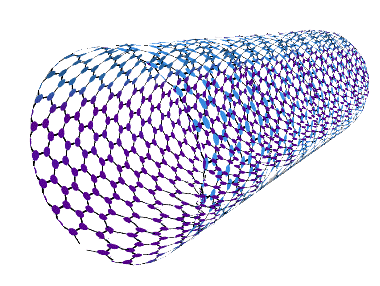Nanochemistry:
Nanotubes

Multi-walled

Single-walled
Single walled carbon nanotubes (SWNTs) can be visualized as a single layer of graphene rolled into a seamless cylinder. Diameters of SWNTs are typically close to 1nm. Compared to multi-walled carbon nanotubes (MWNTs), SWNTs are more pliable and can be twisted, flattened and sharply bent without breaking. However, SWNTs are also harder to make.
Carbon nanobuds are a hybrid of carbon nanotubes and fullerenes. The fullerenes do not create defects in the surface of the nanotubes, hence preserving the properties of nanotubes while creating room for chemical modifications. The fullerenes serve as reaction sites. Carbon nanobuds hence have the tunable electrical conductivity, high strength, low density, high thermal and mechanical stability of carbon nanotubes, as well as the recativity and low work function of fullerenes.
Torus-shaped carbon nanotubes, or nanotori, have the shape of a ring doughnut. Nanotori have magnetic properties, with certain 'magic' radii producing magnetic moments thousands of times the expected. Other properties such as thermal stability are also reliant on the radius of the torus and tube.

Nanobud

Torus
Types of Carbon Nanotubes Synthesized

Nitrogen-doped Carbon Nanotubes

Graphenated Carbon Nanotubes
Nitrogen-doped carbon nanotubes are carbon nanotubes with Nitrogen molecules introduced. They are highly active electrocatalysts. The introduction of the N group improves the tube's covalent chemistry and can be used to anchor groups or particle that can be used to further functionalization routes.
Graphenated carbon nanotubes (g-CNTs) are a hybrid of carbon nanotubes with graphene "leaves" protruding from the sides. g-CNTs have the high charge density and reactivity of graphene coupled with the alignability of CNTs, making them useful in supercapacitors.
Multi-walled carbon nanotubes (MWNTs) exist in 2 forms:
1. Coaxial assembly of SWNTs
2. A single layer of graphite rolled into a seamless cylinder
Diameters of MWNTs are typically from 5–50nm, and interlayer distance is close to that of layers of graphite. MWNTs are prone to structural imperfections which diminish its desirability.